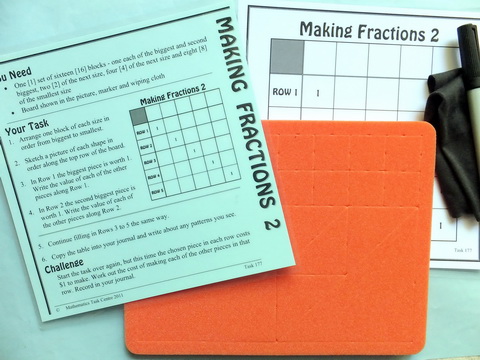
Making Fractions 2Task 177 ... Years 2 - 8SummaryStudents first arrange a set of blocks in order and record the order on the board. The purpose of biggest to smallest ordering is to make more obvious a relationship that connects the pieces when the puzzle is solved. The puzzle is based on value relations. That is, if we give this piece a certain value, what is the value of each of the other related pieces. The assigned value is always 1, in other words, the assigned piece becomes the whole for that row of the puzzle. Other pieces will be related to the whole as fractions or mixed numbers and the first challenge is to find these relationships in each row. The challenge section of the card introduces decimal equivalents by giving the chosen piece the value of $1.Use the Task Cameo Content Finder to discover other tasks involving value relations. Two with a structure almost identical to this one are Making Fractions 1 and Making Fractions 3. |
Materials
Content
|

IcebergA task is the tip of a learning iceberg. There is always more to a task than is recorded on the card. |
The principle of this task is to take a whole, divide into parts, then choose any of those parts in turn to have a value of 1. In effect, the task is based on the concept that any piece, not necessarily the largest one, can be the whole. Making Fractions 2 is based on halves, quarters, eighths and sixteenths of the largest square. To record the biggest to smallest order along the top line of the chart, students can use drawings, or a code such as LS for largest rectangle. The pieces are not intended to fit in these cells. However, some students do stand them on their edge outside the cells. An additional spatial challenge is provided by trying to fit the pieces back into the frame at pack up time. This should be encouraged because it is also a check that all the pieces are there. From largest to smallest the blocks are:

The task supplies half of what is needed for each shape to cover the largest square. However this is plenty to be able to work out the order of the pieces (by area) and their fraction relationships. When correctly filled in the table is:
Encourage students to look for patterns in the table. They will find many doubling and halving connections and the rows might even be used to introduce powers of 2 and patterns in the way they are written. Consider Row 5 for example. It could be rewritten as 24, 23, 22, 21. Then, to fit pattern, 1 must surely be written as 20. Applying this new knowledge to Row 4 next makes us wonder if we could write 1/2 in this power format. And what about 1/4, 1/8 and 1/16? If encouraged to continue examining the table, students might see that cell values reflected in the leading diagonal are reciprocals of each other - that is, their product is 1. Example
Challenge In non-rounded form, and using decimals, the table becomes:
More Fraction Calculations Fractions are all about knowing what the whole is, dividing the whole into equal parts and then, as a consequence of the partitioning, being in a position to choose and use the appropriate fraction language. For example: Four of these equal parts make the whole so each part is ...worth one fourth (...called one fourth). Now, other fraction statements (stories? / equations?) are obvious from the pieces such as:
If that same whole can be divided into equal parts in another way, then a different fraction word comes into play and equivalent fractions are possible. Taken all together, rather than in separate rows, the blocks in this task make a Fraction Set with the largest square as the whole. The pieces show that A can be partitioned into halves, fourths, eighths and sixteenths and there is a world of fractions equations to discover and record within the blocks. Students will soon be making up equations which imagine more pieces than are available.
Examples
A Little Extra
|
Whole Class InvestigationTasks are an invitation for two students to work like a mathematician. Tasks can also be modified to become whole class investigations which model how a mathematician works. |
To convert this task to a whole class investigation each pair (or perhaps group of 4) will need a set of blocks. Or something similar can be made from wood or card and the eTask Pack provides a master for this purpose. However, creating enough sets in this way might place an excess demand on finances or time. Instead, consider using a work station approach where this task and several others with mathematics similar to that listed in Content Finder, are one station. The other work stations might be text based work on value relations and software involving value relations, such as that for the Maths300 companion lesson of Task 75, What's It Worth?. With a system like this, where the text and software stations tend to 'look after themselves' the teacher can often find time to spend with the task group to listen to, question and assess their mathematical discussion. At this stage, Making Fractions 2 does not have a matching lesson on Maths300. |
Is it in Maths With Attitude?Maths With Attitude is a set of hands-on learning kits available from Years 3-10 which structure the use of tasks and whole class investigations into a week by week planner. |
The Making Fractions 2 task is an integral part of:
|